Articolo presentato alla 16th Conference on transportation systems AUTOMATION IN
TRANSPORTATION ’96 – Split Croatia
Autori
Andrea Gatti – Ferrovie dello Stato ASA Materiale Rotabile e Trazione, V.le Lavagnini, 58 FIRENZE Italy
Gianosvaldo Fadin, Diego Quagreda, Enrico Rimini – I.PRO.M. Srl via Tombetta 95, 37135 VERONA Italy
Summary
The requirement of virtuality is foreseen to be very strong on the human interface nowadays and in the next future. Instrumentation and diagnostics visualisation are now asking for on the fly changing of functional parameters and languages on demand of the driver as it is on an international locomotive crossing the border between Italy and France or Italy and Austria. The introduction of networking is asking for a distributed architecture and virtual functions at application level. The paper describes a human interface that is based on a colour display and a microprocessor control unit capable of executing macro functions remotely loaded. This human interface is suited for instrumentation and diagnostic data presentation which are believed to have no safe constraints; the safety aspects are analysed in the last part of the paper and hints are given for the design. Finally future trend is evaluated.
Introduction
The rolling stock are, as every one knows, mainly made by iron, that may be said real hardware; but nowadays very sophisticated equipment are playing a role more and more important for a modern, comfortable and reliable service.
Complex electronic and informatic equipment are now highly required and, specially in high speed train and international train, the different equipment are connected by a communication network for the purpose of automation (multitraction, door control, conditioning etc.), on line diagnostics and passenger information.
One of the areas where this issue applies dramatically is the Man Machine Interface as already shown by [1] in 1989.
International train and, in the near future, high speed train are crossing borders on European countries changing traction power system (i.e. from DC to AC or vice versa) and signalling system.
As a consequence both instrumentation visualisation and diagnostic visualisation have to change language, displayed values and ranges and, for the time being, presentation shapes.
This may be accomplished only if the concept of virtuality is introduced.
A novel terminal was proposed, experimented by FS and now installed and on service on Italian locomotives.
This paper describes the requirements of virtuality that were implemented both from the point of view of visualisation and from the point of view of functionality and TCN network connectivity.
Then the main characteristics of the FS terminal are described and finally the MMI (Man Machine Interface) for the ETCS (European Train Control System) is considered in order to evaluate the capability of the FS terminal to cope with the future trend of the European railway scenario.
Virtuality requirements
The requirements of virtuality are coming from two different application issues: the visualisation and the communication.
Figure 1 shows a model that structures the basic functionalities of a device that needs visualisation service and figure 2 shows a model that links the communication interface and the user application resident in the devices in charge of a specific function. These models were proposed in [2].
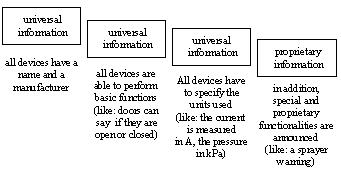
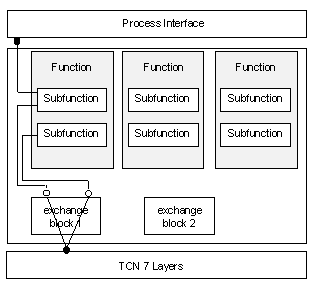
Visualization requirements
The MMIs to be installed in the driver cab ask for the capability of displaying the following information:
- locomotives instrumentation values;
- coach diagnostic values;
- maintenance information.
Such an information may change from vehicle to vehicle and, within the same vehicle, for example an international coach or locomotive, it may change depending from the railway ruling, environs and national system where the vehicle is operated.
This is easy to understand if the reader considers the difference caused by:
- languages;
- brake details;
- monitoring fashion and habit;
- planning technique to anticipate future events;
- parameters ranges and measuring units.
These requirements are leading to a solution that is based on a screen display able to animate instrumentation and to visualise messages using a host programmable technique.
Communication requirements
Figure 3 shows a typical architecture of a modern locomotive. It is shown the case of a locomotive with only one driver cab, in the case that two driver cabs are installed, the structure is just the double.
The following short forms explanation apply to the figure 3:
- EB: signalling transceiver
- DT: Diagnostic Terminal
- IT: Instrumentation Terminal
- GW: TCN Gateway
- DC: Diagnostic Computer
- BCS: Brake Control System
- TCS: Traction Control System
- VCS: Vehicle Control System
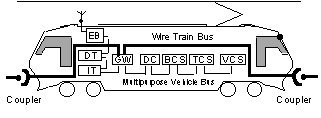
The communication requirements ask for virtuality in the functions that have to be performed so that the physical units like DT and IT have to provide very basic and elementary functionalities that may be invoked loading into such units macrocommands from the host in order to perform the application specific tasks.
DT and IT shall announce their characteristics and basic capabilities by means of the Train Communication Network at the initialisation Phase and have to be loaded by the host that, for example, may be the Diagnostic Computer.
Basic graphic functionalities
In order to implement the virtual capabilities described in the previous chapter, the Graphic Terminal is able to execute elementary functions called by ESC Sequences.
On the following description more details are given in [3]
The elementary functions may be classified as:
Basic Graphic functions
- -Origin definition
- -Co-ordinates rotation
- -Rectangle, Vector, Ellipse, Pixel, Circle, Polyline,
- Polygon Drawing
- -Area Filling
- -Image Copy
Basic Character Functions
- – Two Font Tables
- – Character String Parameter pre-setting
- – Character String put
- – Underline
- – Backspace, line feed, carriage return
Miscellaneous Functions
- – Area Blinking, Zooming, Partial erasing
- – Buzzer, Brightness, Contrast control
- – Cursor control
- – Page selectionInstruments
- – Instrument definition and animationMacro
- – Macro definition
- – Macro call
- – Macro down-loading
Keyboard
- Two key rollover
Macrocommands
Both IT and DT have to implement the ST 306127 [4] specification in its own firmware; no application firmware can exist according to the FS specs.
The application is executed through calls of Macrocommands downloaded into the terminal Flash Eprom.
These macrocommand are called by the sequence:
<ESC> X(N)
where N is the address of the macro stored in Flash.
Macros can draw background Images, draw and animate instruments, write character strings in a very efficient way.
Up to 32 instruments may be animated simultaneously on the same page.
Each instrument is animated sending a 16 bits integer using the sequence:
<ESC> @ D(N) ; (V)
The zero scale and full range position and value are defined using the function “Instrument definition” that is loaded in the Flash too.
Config Register and Status Register
The Config Register stores useful information like:
- – Type of Display
- – Vehicle code id
- – Application version code
The Status register summarises statuses and error codes.
TCN communication functionalities
In order to program by means of Macrocommands the communication capabilities required by a smart application resident on a device compliant to TCN [5] the following basic functionalities are available:
- Universal time sinking and synchronising
- Keyboard local management
- Global and local variables management by means of the following operations on variables:
- addressing
- casting
- copying
- reading/writing
- testing
- monitoring
The testing and monitoring of variables are powerful operations that may start macro execution (like instrumentation animation and message visualisation or page changing) that are performing specific visualisation tasks synchronised or generated by events like alarms, failures, status changes, variables updating.
Visualizzation examples
Figure 4 shows a page relevant to the Instrumentation Terminal.
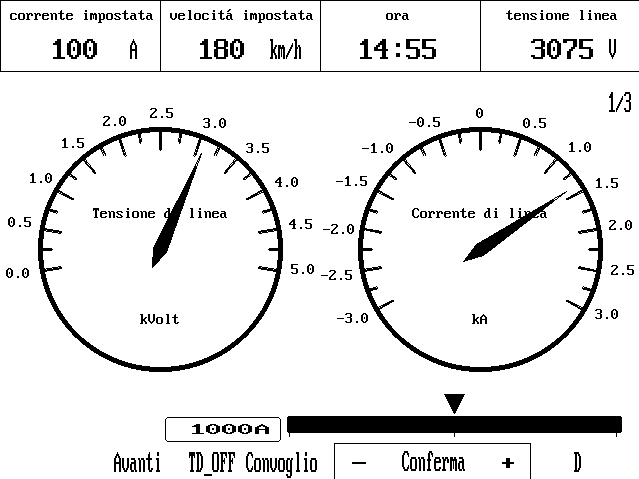
Figure 5 shows a page relevant to the diagnostic Terminal where the train composition and the communication network is reported.
Note that on both figures soft keys are present in the lower part of the screen, particularly in the lower right hand of the screen the soft key “D” appears and has the functionality, when pushed, to display the same page in German language.
In such a case the soft key is changed to “I” so pushing it the Italian language is again in use.
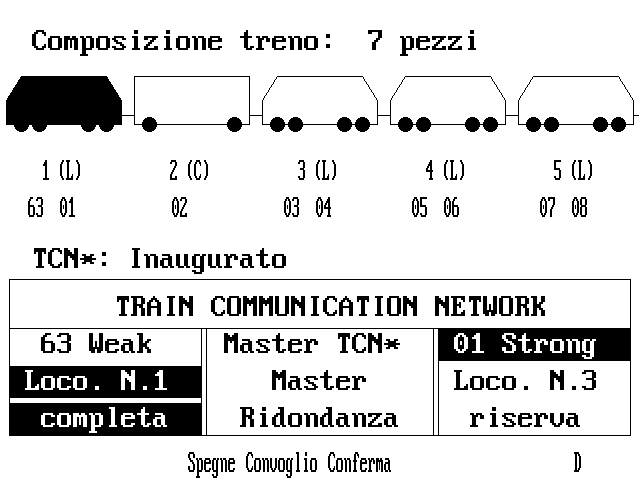
Future trends and conclusion
The UIC/ERRI A 200 working group is in charge of studying the European Train Control System (ETCS) as one of the projects launched to reach the aim of an European Rail Traffic Management System (ERTCS), an automatic train protection and control [6].
Within such a project a proposal for the ETCS-MMI, a standard Man Machine Interface, is under development.
The ergonomics is the main goal to be reached and basic concepts are developed for the colours, shapes and integration/separation of safety/non safety messages visualisation.
Moreover the IEC TC9 WG22 SGA and the IEC TC65 (the IEC Automation Committee) are developing proposals for the modelling of virtual functions on physical devices.
As the paper has shown a method and specification for implementing a terminal with virtual visualisation and communication capabilities was developed by FS and applied to Italian locos like E412 and E402B; in the future it is expected that such terminal is capable to apply the results coming from UIC/ERRI and IEC to reach what may be called a standard virtuality.
References
[1] Dott. Ing. Sergio d’Arminio Monforte, Dott. Riccardo Dominici, Dott. Ing. Gregorio Feigusch, Dott. Ing. Giorgio Gomisel -“Aspetti ergonomici dei sistemi avanzati di supervisione e controllo nei moderni rotabili di trazione” – Ingegneria Ferroviaria N. 8 Agosto 1989.
[2] Doctor Hubert Kirrmann, IEC TC9 WG22 Sub Group Application – Working Papers
[3] A. Gatti – “Comandi per Terminale Grafico” Specifica n. 307948 esp 01 – Ferrovie dello Stato ASA Materiale Rotabile e Trazione, Servizi Tecnici
[4] A. Gatti – “Terminale Grafico” Specifica n. 306127 esp 06 – Ferrovie dello Stato ASA Materiale Rotabile e Trazione, Servizi Tecnici
[5] IEC TC9 WG22 376 CDV – published by Central Office of IEC Geneva, future IEC1175 Train Communication Network standard.
[6] UIC/ERRI A200 ETCS-MMI team – ETCS-MMI (draft 6) Requirement, explanation and description – November 1995
